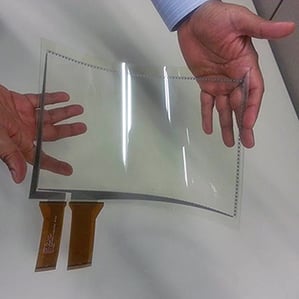Nanomaterials Could Enable Large, Flexible Touch Screens
3M will begin selling flexible transparent conductive films made of silver nanowires for use in touch screens. These nanomaterials could enable wider adoption of large touch screens for interactive signs, displays, and personal computers. And the flexible films may come to be used in future foldable, curvy personal electronics, too.

The St. Paul, Minnesota, company will make the films using silver nanowires produced by Cambrios, a Sunnyvale, California, startup founded in 2004 by two materials scientists: Evelyn Hu, now at Harvard University, and MIT’s Angela Belcher. The company’s silver nanowires are a few nanometers in diameter and a few micrometers long, and come suspended in inks. The inks can be spread out onto a surface to make sparse films. The silver wires are designed to spread in random networks, like nano pick-up sticks, so that they won’t cause a pattern that’s distracting to the eye—an irritating problem that plagued earlier metal-mesh touch screens.
The films are mostly empty space, so they’re transparent. But the nanowires and the ink are formulated so that these films are still highly conductive. The company claims that electrodes made from its ink are more conductive and transparent than the most commonly used touch screen material. Cambrios also says the material can be rolled and unrolled over 100,000 times without breaking.

That’s in contrast to today’s touch screens, which are made of brittle indium tin oxide films. These conventional touch screens have made new kinds of interfaces possible in small devices like smartphones and tablets. But touch screens using the current materials are limited in size and design. The electrical signal has to travel from the touch all the way to the edge of the display, where it’s picked up. If the signal has to go very far, it becomes too weak, and the screen isn’t responsive enough. To make indium tin oxide electrodes more conductive and boost that signal, manufacturers can lay on thicker films, but that makes the display less transparent.
The new nano films could also be beneficial for conventional rigid displays. Indium tin oxide is deposited onto sheets of glass in vacuum chambers; half the material lands not on the glass but on the inner surfaces of the chamber and must be recovered and reused. The nanowire inks can be coated more efficiently and can be made on thin, flexible sheets of plastic rather than glass. 3M uses PET, the same plastic found in many water bottles. Glass is getting thinner and lighter, and touch screens built on plastic should be thinner and lighter still—a selling point for cell phone makers.
3M is not the first company to start selling a touch screen product that uses Cambrios inks. In October 2012, Cambrios announced that its inks were being used in LG’s all-in-one computer and some displays; the Cambrios materials are also found in cell phones and tablets made by NEC in Japan and Huawei in China. Supplying nanowires to 3M, however, will enable the company to get into more devices. 3M is making the touch screen films for device makers but has not yet named customers.
Keep Reading
Most Popular
Large language models can do jaw-dropping things. But nobody knows exactly why.
And that's a problem. Figuring it out is one of the biggest scientific puzzles of our time and a crucial step towards controlling more powerful future models.
The problem with plug-in hybrids? Their drivers.
Plug-in hybrids are often sold as a transition to EVs, but new data from Europe shows we’re still underestimating the emissions they produce.
Google DeepMind’s new generative model makes Super Mario–like games from scratch
Genie learns how to control games by watching hours and hours of video. It could help train next-gen robots too.
How scientists traced a mysterious covid case back to six toilets
When wastewater surveillance turns into a hunt for a single infected individual, the ethics get tricky.
Stay connected
Get the latest updates from
MIT Technology Review
Discover special offers, top stories, upcoming events, and more.